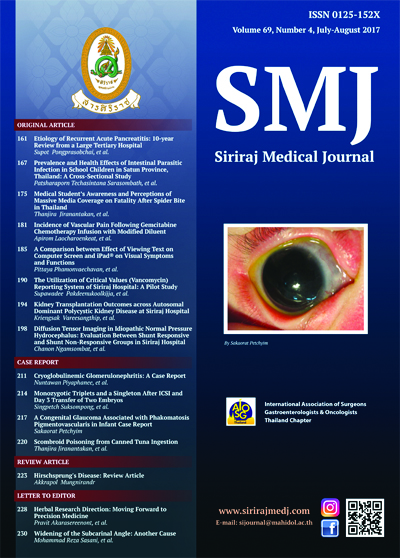Kidney Transplantation Outcomes across Autosomal Dominant Polycystic Kidney Disease at Siriraj Hospital
Keywords:
ADPKD, kidney transplantation, outcome, ThailandAbstract
Background: Thailand has a population of 65 million. The estimated incidence of chronic kidney disease (CKD) patients is approximately 17%. Siriraj Hospital has performed kidney transplantations since 1973. With 43 years of experience, a total of 1,150 kidney transplantations (65.5% were deceased donors and 34.5% were living donors)
were performed at Siriraj Hospital. Autosomal dominant polycystic kidney disease (ADPKD) is the most prevalent, potentially lethal, monogenetic disorder with the prevalence of 1:500-1:1000 worldwide. It is the fourth leading cause of end-stage renal disease (ESRD). The characteristic of ADPKD is the enlargement of kidney from numerous cysts present on the renal tubules which gradually grow resulting in the decline of glomerular filtration rate (GFR)
and eventually turning into ESRD.
Objective: We aimed to study the outcome of kidney transplantation in ADPKD recipients at Siriraj Hospital.
Methods: Thirty-one ESRD-ADPKD patients (male 22, female 9) received kidney transplantation at Siriraj Hospital. Twenty-eight patients (90.3%) were deceased donors and 3 patients (9.7%) were living donors. All living donors were performed genetic tests, including linkage study and mutation test, to exclude ADPKD relatives who carried
abnormal PKD genes.
Results: The kidney allograft survival at 1-, 5- and 10-years were 81%, 81% and 54%, respectively. The results of patient survival at 1-, 5- and 10-years were 94%, 90% and 75%, respectively.
Conclusion: Kidney transplantation provides excellent patient and graft survival rates and is the preferred treatment option for patients with ADPKD and ESRD.
Downloads
Published
How to Cite
Issue
Section
License
Authors who publish with this journal agree to the following conditions:
Copyright Transfer
In submitting a manuscript, the authors acknowledge that the work will become the copyrighted property of Siriraj Medical Journal upon publication.
License
Articles are licensed under a Creative Commons Attribution-NonCommercial-NoDerivatives 4.0 International License (CC BY-NC-ND 4.0). This license allows for the sharing of the work for non-commercial purposes with proper attribution to the authors and the journal. However, it does not permit modifications or the creation of derivative works.
Sharing and Access
Authors are encouraged to share their article on their personal or institutional websites and through other non-commercial platforms. Doing so can increase readership and citations.











